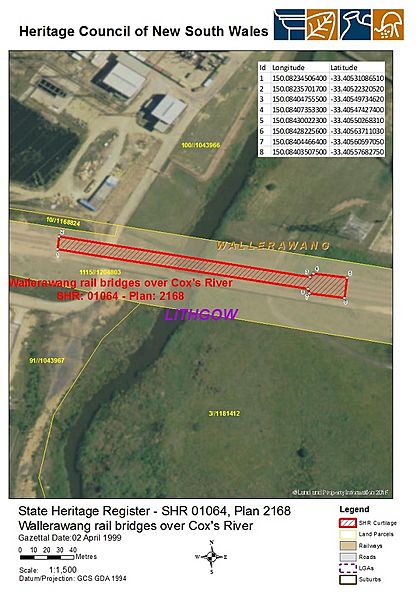Coxs River railway bridges, Wallerawang facts for kids
Quick facts for kids Coxs River railway bridges |
|
|---|---|

Heritage boundaries
|
|
| Coordinates | 33°24′19″S 150°05′00″E / 33.4054°S 150.0833°E |
| Carries | Main Western line |
| Crosses | Coxs River |
| Locale | Wallerawang, City of Lithgow, New South Wales, Australia |
| Owner | RailCorp |
| Characteristics | |
| Design | Arch viaduct |
| Material | Stone and masonry |
| Total length | 139.6 metres (458 ft) |
| Longest span | 16.5 metres (54 ft) |
| Number of spans | 17 |
| History | |
| Designer | John Whitton |
| Contracted lead designer | New South Wales Government Railways |
| Construction end | 1870 |
| Official name: Wallerawang rail bridges over Cox's River | |
| Type: | State heritage (built) |
| Designated: | 2 April 1999 |
| Reference #: | 1064 |
| Type: | Railway Bridge/ Viaduct |
| Category: | Transport - Rail |
| Builders: | Day labour |
The Coxs River railway bridges are two old and important railway bridges. They carry the Main Western train line over the Coxs River near Wallerawang, New South Wales, Australia. These bridges were designed by engineers from the New South Wales Government Railways. They were built in 1870. Today, RailCorp owns them. The bridges were added to the New South Wales State Heritage Register in 1999. This means they are protected because of their historical importance.
Contents
A Look Back at the Bridges' Story
Why New Bridges Were Needed
In the early 1900s, the single train track from Bowenfels to Wallerawang wasn't big enough. It couldn't handle all the trains. So, plans were made to add a second track. This was called "duplication." At the same time, engineers wanted to make the train path smoother. They aimed to "ease the grades" (make slopes less steep) and "flatten some curves" (make turns less sharp).
The "Era of the Brick Arch"
A big project to upgrade railway lines started in 1910. It continued until the mid-1920s. During this time, steel was very expensive. It had to be brought in from Britain. Because of this, builders used a lot of bricks to make bridges over rivers and valleys. Many bricks came from the State Brickworks at Homebush, which opened in 1912. Most bridges were made of brick arches. This period is often called the "era of the brick arch."
Normally, a 6.1-metre (20 ft) wide gap would have a simple steel bridge. But because steel was hard to get, brick arches were still used. The work on the Bowenfels to Wallerawang line was delayed. It only started after World War I ended.
How to Visit the Bridges
You can easily reach this bridge. Just take Springvale Lane, which is off the Mudgee Road. It's located south-east of the Wallerawang Power Station.
What Makes These Bridges Special?
A Big Engineering Achievement
The Coxs River railway bridge is a huge technical success. It has seventeen stone arches. These arches together stretch 139.6 metres (458 ft). This makes it the longest bridge made of stone arches ever built in Australia.
Its main arch is 16.5 metres (54 ft) wide. This was also very large for a bridge built in 1870. It's special because its arch is shaped like an ellipse, not a perfect circle. The main arch has strong stone supports on its sides. These supports go up above the bridge's top surface.
Unique Design Features
The way the bridge's curved parts (called "spandrels") are built is also unusual. The lines from the arch go all the way up to fill the entire spandrel area. This design makes the bridge a very important part of New South Wales' railway history.
The bridge still has its original parts. This means it looks much like it did when it was first built.
Why These Bridges Are Protected
A Heritage-Listed Landmark
As of 2006, this 1870 bridge is very important. It is one of the oldest stone arch railway bridges in New South Wales. It is connected to John Whitton, who is known as the "father of New South Wales railways."
The bridge is an impressive sandstone structure. It sits just outside the historic town of Wallerawang. Building this bridge helped a lot with extending the railway line to Bathurst and further into western New South Wales.
John Whitton's Vision
When John Whitton couldn't get enough money for expensive wrought iron bridges, he chose stone arch bridges instead. He used them for his biggest bridge projects. These included the famous Zig Zag railway east of Lithgow and the line extending west to Wallerawang. The Coxs River bridge is the largest of all Whitton's stone arch bridges. It's a great example of a stone arch railway bridge and still has its original features.
The Wallerawang rail bridges over Cox's River were added to the New South Wales State Heritage Register on April 2, 1999. This means they meet certain important standards.
Showing History and Progress
- The bridge shows how history unfolded in New South Wales. It was part of the project to add a second track between Bowenfels and Wallerawang. This was one of the last big railway projects that mainly used brick arches.
- The bridge has a special meaning for the community. The work to add a second track helped a lot. It allowed the railway to reach Bathurst and helped Western New South Wales continue to grow. It made land transport to Sydney much easier.
- The bridge can teach us about history. Brick arches were still the most common type of railway bridge in the early 1920s. This was because there wasn't much steel available after World War I.
- The bridge is a great example of its kind. It shows the main features of brick arch construction very well.

